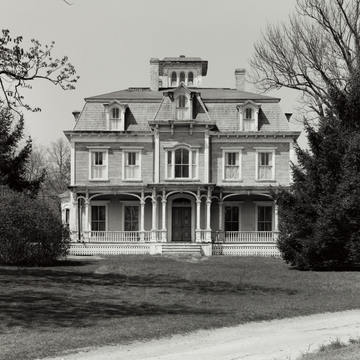If the White store at Tiverton Four Corners is a set designer's vision of a rural commercial Victorian building, Dr. Whitridge's country house is the equivalent for the rural house. (Could the same designer have done both?) Again, we see the full Victorian Second Empire panoply of tall porch with square posts on sturdy plinths, slightly convex mansard, and tall, arcaded cupola. Here, however, the projection of the building at the center aggrandizes the entrance approach, which begins with a long private drive in from the road; porch posts are doubled with wooden arching jumping from pair to pair; upper windows are more magnificently framed. Both store and house are commanding. Yet both maintain a spare, airy quality appropriate to country building. The two-part composition of this house documents the generational rise of one family. The rear section is a south-facing house built just before the Revolution by Dr. William Whitridge. Its configuration is somewhat unusual, with paired center chimneys flanking a center stair. Whitridge's son Thomas, “a greatly respected merchant of Baltimore,” owned the house by the 1860s and added the Victorian frontispiece. The scale of the front section—particularly its height—is exceptional in rural Rhode Island. Does it owe these qualities to a Baltimore architect and to Thomas Whitridge's preference for the breezy amplitude of southern dwellings for his summer estate?
You are here
Dr. William Whitridge and Thomas Whitridge House
If SAH Archipedia has been useful to you, please consider supporting it.
SAH Archipedia tells the story of the United States through its buildings, landscapes, and cities. This freely available resource empowers the public with authoritative knowledge that deepens their understanding and appreciation of the built environment. But the Society of Architectural Historians, which created SAH Archipedia with University of Virginia Press, needs your support to maintain the high-caliber research, writing, photography, cartography, editing, design, and programming that make SAH Archipedia a trusted online resource available to all who value the history of place, heritage tourism, and learning.

